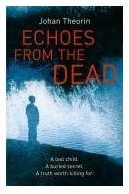Peter, as usual, is ahead of the game and gives us an early glimpse of the fifth book in Camilla Lackberg’s series, The Hidden Child, which takes a look at wartime secrets and makes the pages turn quickly.
He also catches us up with Norwegian author Thomas Enger and his new book, Burned, which he finds fascinating, convoluted, and with a terrific ending.
Ben Martin at the Advocate has some stern things to say about crime fiction that is stooping too low – he’s quite cross about Lars Kepler’s The Hypnotist and Jo Nesbo’s The Snowman.
What made Mankell and Larsson so compelling was the determination by their protagonists to master the evil. Without this moral dimension, such tales are merely horrific. . . .
The Hypnotist, by a Swedish couple writing under the pseudonym Lars Kepler, is a repellent book. Its special nightmare quality is the involvement of children in crimes of murder, kidnapping, rape and mutilation, either as victims or perpetrators. . . .
Jo Nesbo’s The Snowman, inspires similar dread . . . As the chapters proceed, the means of death grow more gruesome, the motives more obscene.
But he praises Hakan Nesser and especially Arne Dahl, whose Misterioso is finally going to be available in English. He says is “truly fine” and the first translation in a series that is a worthy successor to Mankell’s Kurt Wallander series.
Lucky Bernadette has already read Johann Theorin’s The Quarry, which is set on his favorite island, this time in the spring. She writes:
As has been the case with the previous two novels of this series I was once again enveloped by the atmosphere Theroin, ably aided by his translator Marlaine Delargy, has created here. It didn’t feel like I was just reading about the island’s slow awakening from it’s harsh winter to spring: I lived through the lengthening days, the appearance of the first butterflies, the people getting to know each other and themselves. I loved every moment of this book from its first word to its excellent closing line.
As these are seasonal books, and we’ve had three, I’m afraid we have only one more left.
Keishon, the avid mystery reader/blogger, thinks highly of Theorin’s Echoes from the Dead, saying, “I always find myself thoroughly immersed in his stories. To me Johan Theorin is a natural-born storyteller whose novels are often described as “chilling” and “atmospheric.” He has a strong authorial ‘voice.'” She also does her part to combat grade inflation, causing a bit of controversy.
Maxine Clarke reviews Arnaldur Indridason’s Outrage at Euro Crime; this ninth volume in the Erlendur series is much more about his colleague, Elinborg, who investigates a murder the old-fashioned way, teasing out every clue and learning as much as possible about the victim. As Maxine points out, procedurals that avoid technical gee-wizardry are less likely to date themselves. All around, a good mystery, though the who dunnit aspect is less successful than the overall depiction of an investigation and the people involved in it.
Peter Rozovsky reviews a dark and violent crime story – Harald’s Saga, one of those early Icelandic thrillers that (along with Ed McBain) influenced Arnaldur Indridason’s style.
In the Wall Street Journal, Tom Nolan reviews The Hypnotist, finding it (appropriately) mesmerizing and (perhaps less appropriately) grisly. Though, he concludes, when you live in the wild north “sometimes you need an ax.”
Norm reviews Camilla Ceder’s Frozen Moment at Crime Scraps and wonders if mysteries today aren’t indulging in a bit too much backstory. If the review had to be summarized in one syllable, it might be “m’eh.” Meanwhile, update your RSS feeds, as Crime Scraps has finalized its divorce from Blogger.
Elaine Simpson-Long, Opera Lover, also loves Henning Mankell’s elegaic coda for the Kurt Wallander series, The Troubled Man, though she’s sorry it’s the last one.
I find when reading Mankell’s books that the narrative style and flow is very even and balanced, no sharp, short sentences or any breaks. The reader is gently taken along and after a while it is almost a soothing experience to read this author and this ebb and flow reflects the character of Kurt Wallander himself, it is almost hypnotic . . . A thoughtful quiet read and well worth it.
BBC’s World Book Club offers a lengthy and informative interview with Henning Mankell. Hat tip to Mediations for the link.
The Material Witness reviews Sofi Oksanen’s Purge and gives it high marks for psychological stealth and subtlety. For some reason, I hadn’t realized she’s Finnish, so belongs here (though the setting is Estonia, and there is some dispute over whether this book can properly be called crime fiction).
Barry Forshaw has a lengthy and interesting essay in The Independent about Norwegian crime writers and their thoughts about the genre, making a brief stop on his way to publishing a book on Scandinavian crime fiction to be titled Death in a Cold Climate. Peter Rozovsky writes about it at his blog with a pun clever enough to cause toothache.
And if you haven’t had your fill of The Girl, Variety has an article about David Fincher’s US remake of the Millennium Trilogy films; all the Swedes interviewed seem to be pleased with it, where apparently Fincher has fans. They are also relieved that it hasn’t been moved from Sweden to a US setting or filmed on location in the nearest Ikea store to Hollywood.
Hang onto your wallets: the tireless sleuth, Karen Meek, has uncovered new publications coming out in August in both the UK and US markets, including some newcomers to English translation: Norwegian Jørn Lier Horst, Swedish Stefan Tegenfalk, and Finnish Monika Fagerholm (who has one other book that has been translated into English previously).



 The Guardian
The Guardian